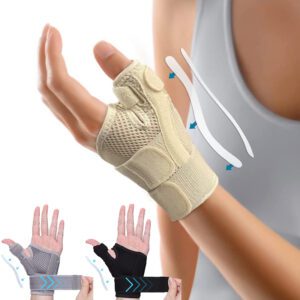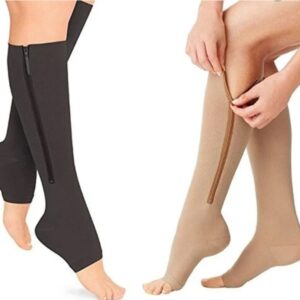So, you’ve been feeling a nagging pain in your foot that just won’t quit? It’s got you hobbling around like an old pirate with a wooden leg, right? Well, my friend, it sounds like you’ve got a case of plantar fasciitis.
Now, before you run off to Google and start self-diagnosing (or worse, self-treating), let’s sit down, take a deep breath, and talk this through. Dealing with plantar fasciitis can be a bit tricky, but don’t worry, you’re not alone in this.
In this article, we’re going to talk about some common mistakes people make when dealing with plantar fasciitis – things that can actually make the condition worse or prolong your recovery. Trust me, I know it’s tempting to ignore the pain or to try every home remedy under the sun, but sometimes what you don’t do is just as important as what you do.
So, grab a cup of coffee, put your feet up (gently!) and let’s dive into this together. Knowledge is power, after all, and the more you know about what not to do, the better equipped you’ll be to get back on your feet. Literally. Let’s get started!
Ignoring the Pain and Discomfort: The Fool’s Strategy
Ah, plantar fasciitis, the bane of many a foot enthusiast. It starts innocently enough with a twinge of discomfort in the heel or arch of your foot. But what do you do?
You ignore it, foolishly thinking it will magically disappear. Oh, how wrong you are! Ignoring the pain and discomfort associated with plantar fasciitis is like ignoring a wailing fire alarm in your house – it’s a recipe for disaster.
Let me enlighten you, dear readers. Plantar fasciitis is an inflammatory condition that occurs when the thick band of tissue connecting your heel bone to your toes (the plantar fascia) becomes strained or damaged. Do you know what happens when you ignore this condition? It worsens!
That niggling pain intensifies into excruciating agony that makes each step feel like walking barefoot on hot coals. Trust me; I’ve seen grown men reduced to tears because they thought they could simply tough it out.
The Consequences of Neglecting Symptoms: A Road Paved with Regret
If you think ignoring plantar fasciitis will make it magically disappear, let me burst that bubble of delusion right now. Neglecting these symptoms can have severe consequences for your foot health and overall quality of life.
Picture this: every day you wake up and take those first few tentative steps out of bed only to be greeted by shooting pain through your heel and arch. Simple tasks like walking to the bathroom or even standing become Herculean challenges.
But wait, there’s more! If left untreated, that innocent little inflammation can lead to long-term damage to your precious plantar fascia. In extreme cases, this delicate tissue can tear, causing even more excruciating pain and potentially requiring surgical intervention.
So dear reader, if you value your mobility and freedom from agony, do not – I repeat, DO NOT – ignore the warning signs of plantar fasciitis.
The Importance of Proper Care and Treatment: A Lesson in Self-Preservation
Now that we’ve established that playing ostrich with your plantar fasciitis is a recipe for disaster, let me introduce you to the concept of proper care and treatment.
It may sound like common sense to some, but trust me when I say that common sense is not so common when it comes to foot health. Proper care begins with acknowledging the symptoms and seeking professional help.
Don’t play amateur doctor with Dr. Google; consult a podiatrist who can provide an accurate diagnosis and tailor a treatment plan specifically for you. This might include a combination of rest, physical therapy exercises, orthotics, or even steroid injections to reduce inflammation. Treatment also requires patience – something many individuals lack in today’s fast-paced world.
Give your foot the time it needs to heal properly before resuming your regular activities or pounding the pavement like an overzealous marathon runner. Remember: Rome wasn’t built in a day, and your recovery won’t happen overnight either.
Dear reader, do not fall victim to the folly of ignoring plantar fasciitis. Acknowledge the pain, seek proper care and treatment from professionals who know what they’re doing (unlike Dr. Internet), and give yourself time to heal. Your foot health is worth it – don’t let ignorance be your downfall!
Long-term damage to the plantar fascia
Neglecting plantar fasciitis is like neglecting a needy houseplant – it will wither away and die if not given the care and attention it deserves.
The longer you ignore the pain and discomfort, the more damage you’re causing to this vital structure. Picture this: every step you take without addressing plantar fasciitis is like taking a sledgehammer to your poor defenseless foot.
With each jarring impact, microtears develop in the plantar fascia. Over time, these tiny tears can accumulate and lead to chronic inflammation and degeneration of the tissue. But here’s the kicker – once you’ve caused irreversible damage to your precious plantar fascia, there’s no turning back.
You can’t magically undo years of neglect with a wave of a wand or a fancy gadget from an infomercial. No amount of “I’m sorry” will bring it back to its optimal state.
So why risk long-term consequences when early intervention could have saved you all this trouble? My fellow sufferers of plantar fasciitis-related agony, let’s not fall into the trap of ignorance.
Ignoring our symptoms will only exacerbate our pain and increase our chances of long-term damage to our poor abused feet. It’s time we stop pretending everything is fine and start taking action toward healing ourselves!
The “Overzealous Athlete” Syndrome
Alright, let’s shift gears and talk about something I like to call the “Overzealous Athlete” Syndrome. You know what I’m talking about, right? It’s that little voice in your head that says “Just one more mile” or “No pain, no gain.” While a bit of grit and determination is great when you’re trying to beat your personal best or push through a tough workout, it’s not always the best approach when dealing with plantar fasciitis.
So, if you’re a fitness enthusiast, an avid runner, or just someone who likes to stay active, this section is especially for you. We’ll be discussing why pushing through the pain isn’t just unhelpful – it could actually be making your condition worse. Let’s dive in and see how we can keep you moving without causing more harm.
Pushing through the pain during exercise
Oh, the relentless determination of athletes! While their unwavering commitment to their sport is admirable, it can sometimes be their downfall when it comes to dealing with plantar fasciitis. Picture this: a dedicated runner, pounding the pavement with every stride, completely ignoring the sharp pain shooting up their heel. Why? Because they believe that pushing through the discomfort will make them stronger. Well, let me burst that bubble of misguided enthusiasm. Plantar fasciitis is an injury that requires careful attention and respect. Ignoring the pain and continuing your rigorous exercise routine will not lead to some heroic feat of endurance; it will only exacerbate your condition. Plantar fasciitis is caused by inflammation and microtears in the plantar fascia ligament located on the bottom of your foot. When you persistently stress this already damaged ligament, you’re essentially creating a breeding ground for further injury.
Understanding the difference between discomfort and injury
Here’s a little nugget of wisdom: discomfort is not synonymous with injury. It’s crucial to learn to distinguish between these two sensations if you want any chance at healing your plantar fasciitis effectively. Discomfort is something we all experience during physical activity; it’s that temporary feeling of fatigue or soreness that vanishes shortly after we finish our workout. On the other hand, injury manifests as sharp or intense pain that persists beyond what would be considered normal post-exercise discomfort. It’s like a nagging reminder from your body telling you to slow down and take care of yourself. Unfortunately, many overzealous athletes fail to grasp this distinction and mistakenly believe that more pain equals greater gains.
Risking further damage by not allowing proper healing time
What is it about patience that seems to elude some athletes? When it comes to plantar fasciitis, rushing the healing process is a recipe for disaster. Your body needs time to repair the damaged tissues and reduce inflammation. If you don’t allow for sufficient healing time, you’re essentially setting yourself up for a never-ending cycle of pain and frustration. By stubbornly refusing to take a break or modify your exercise routine, you risk placing excessive stress on the already compromised plantar fascia ligament. This can lead to chronic inflammation, increased pain levels, and even the development of more severe conditions like heel spurs. So why put yourself through that agony?
Listen to Your Body: It’s Not Weakness
The “Overzealous Athlete” Syndrome stems from a misguided belief that pushing through pain is a sign of strength. But here’s a radical idea: listening to your body isn’t weakness; it’s intelligence. Recognizing when your body needs rest and allowing it time to heal properly is an act of self-care and self-preservation. It doesn’t diminish your athletic prowess; in fact, it enhances it by ensuring longevity in your chosen sport. So let me be clear: pushing through the pain with plantar fasciitis isn’t commendable; it’s foolish. Give yourself permission to rest, recuperate, and seek appropriate treatment methods instead. Remember, true strength lies in knowing when to slow down – not in mindlessly striving forward at the expense of your well-being.
The “Fashion Over Function” Fiasco
Now, let’s move on to a topic that hits close to home for all the fashionistas out there – the “Fashion Over Function” Fiasco. Yes, I know those sky-high stilettos or ultra-cool flip-flops look fabulous and make your outfit pop, but are they worth the pain and discomfort?
In this section, we’re going to talk about why those super stylish, but oh-so-painful shoes might be doing more harm than good when it comes to your plantar fasciitis. So, if you’re someone who often chooses style over comfort when it comes to footwear, stick around. This is a conversation you’ll definitely want to be a part of.
Sacrificing Comfort for Style is a Foot Sin
Ladies and gentlemen, it’s time to address the grave sin committed by those who prioritize fashion over function when it comes to their footwear choices.
Yes, I’m talking about those high heels that elongate the legs and elevate your style, but at what cost? The moment you slip into those towering stilettos, you’re essentially signing a contract with pain and discomfort.
And if you have plantar fasciitis, consider yourself guilty of exacerbating your symptoms. Let’s start with high heels. Oh, the name alone sounds glamorous and enticing. But let me tell you something—those devilish contraptions are nothing short of torture devices for your feet!
They force your toes into an unnatural position and shift your weight forward onto the balls of your feet. Your poor plantar fascia is already inflamed and irritated; do you really want to add insult to injury? No amount of elegance is worth sacrificing the health of your feet. Now, let’s turn our attention to flip-flops-the epitome of summer relaxation.
While they may be convenient for a quick trip to the beach or poolside lounging, they are far from suitable for everyday wear, especially if you’re suffering from plantar fasciitis. These flimsy sandals provide little to no arch support or cushioning for your precious feet. Instead, they leave them vulnerable to strain and stress as the thin sole fails to absorb shock adequately.
So go ahead and enjoy flip-flops in moderation but heed my warning: don’t make them a habit. Unsupportive shoes should also be banished from our closets forever!
I’m talking about those trendy sneakers that offer more style than substance—minimalist shoes with barely any padding or arch support. It baffles me how people can willingly choose to wear footwear that does nothing to alleviate their existing foot pain.
It’s like pouring lemon juice on an open wound! When you have plantar fasciitis, you need shoes that provide ample cushioning, arch support, and stability. Anything less is an insult to your feet and a recipe for prolonged suffering.
We cannot ignore the impact of improper footwear on foot mechanics. The moment you slip into those unsupportive or ill-fitting shoes, you’re altering the way your feet naturally move and function.
With plantar fasciitis, every step becomes a battleground between your inflamed fascia and the ground beneath you. Wearing improper shoes only adds fuel to the fire, causing further strain on your already struggling tendons and muscles.
So let’s make a pact here, right now—to prioritize function over fashion when it comes to our footwear choices. Your feet deserve better than torturous high heels that offer nothing but pain. Opt for shoes with proper arch support and cushioning to alleviate pressure on your plantar fascia.
Give your poor feet a fighting chance by wearing footwear that promotes proper alignment and allows for natural movement. Remember, style should never come at the expense of your well-being!
The “Home Remedies Gone Wrong”
Alright, next on our list is something we’re all guilty of from time to time – the “Home Remedies Gone Wrong”. You know, those late-night internet deep dives that lead you to some obscure blog promising a miracle cure for your plantar fasciitis with just a few simple steps. Sounds tempting, right?
Well, as much as we’d all love a quick and easy fix, it’s important to remember that not all that glitters is gold. In this section, we’re going to explore why some of these well-intentioned home remedies might actually be leading you down the wrong path. So, if you’ve been considering trying out that DIY foot soak or stretching routine you found online, hold up! Let’s take a closer look first. Ready to bust some myths? Let’s get started!
Self-treatment without professional guidance
Oh, the allure of taking matters into our own hands! While I commend the self-reliant spirit, when it comes to plantar fasciitis, it’s time to put down that DIY stretching guide and step away slowly.
Attempting self-treatment without professional guidance is a recipe for disaster. Yes, you may stumble upon a few stretches online promising miraculous results, but let me assure you: most of them are as effective as rubbing a magic lamp and waiting for a genie to miraculously heal your foot.
Let’s discuss one prevalent issue with self-stretching techniques: doing it too aggressively or improperly. Just because you can grab your toes and yank with all your might doesn’t mean you should.
Overstretching the plantar fascia can lead to microtears and exacerbate pain and inflammation in the long run. Remember, gentle stretching is key here – not trying to win an imaginary flexibility competition. In addition to potential overstretching dangers, let’s not forget about the collateral damage that can occur when we don’t know what we’re doing.
Surrounding muscles and tendons are delicate creatures that require proper care and attention. When we take matters into our own hands without professional guidance, we run the risk of inadvertently harming these important structures while attempting to fix one problem.
Therapeutic devices without medical advice
Ah, therapeutic devices – those shiny gadgets promising relief at the push of a button or the velcro strap adjustment. It’s tempting to believe that purchasing an expensive night splint or orthotic will miraculously solve all our plantar fasciitis woes overnight. But alas! This is yet another trap set by misleading marketing ploys.
Let’s first address night splints – contraptions meant to keep your foot flexed during sleep. While they may seem like a good idea on paper, the reality is far from pleasant. Imagine trying to find sleep while having your foot uncomfortably strapped in an unnatural position. It’s akin to torturing yourself in the name of healing. And for what? Questionable results and the possibility of worsening your condition.
Orthotics, those tempting “arch support” wonders lining the shelves of every shoe store, can be just as problematic when used without proper medical advice. Sure, they might provide temporary relief by redistributing pressure on the foot, but unless you’ve consulted a professional who understands your specific needs, you’re merely playing a guessing game with your foot health. Orthotics are not one-size-fits-all solutions; they require personalized assessment and guidance. And let us not forget about taping techniques – an art form that should be left to professionals trained in its application. Incorrect usage can lead to dire consequences such as restricted blood flow or even aggravating the very issue you were hoping to solve.
So put that roll of tape down and step away slowly until you have sought proper guidance from a qualified healthcare provider.
My dear readers, when it comes to home remedies for plantar fasciitis, heed my words of caution: proceed with utmost care and seek professional guidance before embarking on any self-treatment journey.
Remember that hasty attempts at self-care can worsen your suffering rather than alleviate it. Your feet deserve nothing less than expert care and attention because let’s face it – we don’t want another DIY disaster turning our walk into a wince-filled hobble!
The “Drastic Measures” Dilemma
Alright, next on our list is something we’re all guilty of from time to time – the “Home Remedies Gone Wrong”. You know, those late-night internet deep dives that lead you to some obscure blog promising a miracle cure for your plantar fasciitis with just a few simple steps. Sounds tempting, right?
While it would be wonderful to have a quick and effortless solution, it is important to keep in mind that appearances can be deceiving. In this segment, we will delve into the reasons why certain well-meaning home remedies may, in fact, steer you in the wrong direction. Therefore, if you have been contemplating trying out that DIY foot soak or stretching routine you stumbled upon online, pause for a moment! Let us examine it more closely before proceeding.
Unproven alternative treatments
Ah, the allure of untested remedies! People with plantar fasciitis seem to have a penchant for exploring every nook and cranny of the alternative medicine world. From magnetic therapy to acupuncture, and even herbal remedies, they leave no stone unturned in their quest for relief. But let’s be clear: these treatments have little to no scientific backing. While some individuals may swear by them, anecdotal evidence does not equate to solid proof.
Magnetic therapy
Whoever came up with this idea must have watched too many science fiction movies. The notion that wearing magnets on your feet will magically heal an inflamed plantar fascia is nothing short of ludicrous. Don’t waste your time or your hard-earned money on these useless gimmicks.
Acupuncture
While acupuncture has been shown to provide some pain relief for certain conditions, its effectiveness in treating plantar fasciitis remains questionable at best. Sticking needles into strategic points on your body might sound intriguing in theory, but when it comes to this painful foot condition, there are better options out there.
Herbal remedies
Sure, nature is full of wonders and medicinal plants have been used for centuries in traditional medicine. But before you start concocting potions from unknown herbs found in some obscure corner of the internet, think twice. There is simply not enough scientific evidence to support the efficacy of these herbal remedies specifically for plantar fasciitis. Possible financial loss with no improvement in symptoms: Not only are these unproven alternative treatments questionable from a medical perspective, but they can also drain your wallet faster than you can say “snake oil.” Desperate individuals often fall victim to the promises of quick fixes, only to find themselves with empty pockets and a persistent, unrelenting pain in their feet. Save your money for treatments with a solid foundation of scientific research.
Surgical intervention as a first-line option
When all else fails, some individuals resort to surgical intervention without exhausting other conservative treatment options. It’s like using a sledgehammer to crack a nut. Surgery should be the last resort, not the first line of defense. Cutting into your foot should not be taken lightly and should only be considered when all other non-invasive treatments have been thoroughly explored and proven ineffective. Conclusion:In the quest for relief from plantar fasciitis, it’s crucial to avoid falling into the traps of unproven alternative treatments and rushing into surgical interventions prematurely. Stick to evidence-based treatments recommended by healthcare professionals who specialize in managing this condition. Remember that patience is key when dealing with plantar fasciitis; with diligent self-care, proper footwear choices, targeted stretching exercises, physical therapy, and other proven methods, you can find relief without resorting to drastic measures or wasting your time chasing false promises. So take heart! With persistence and smart decision-making, you can overcome this nagging foot ailment and get back on your feet – pain-free.
Final Words
We’ve journeyed together through the treacherous waters of plantar fasciitis, uncovering common pitfalls and mistakes along the way. From the “Overzealous Athlete” Syndrome to the “Fashion Over Function” Fiasco, from misguided “Home Remedies Gone Wrong” to the precipitous “Drastic Measures” Dilemma, we’ve explored them all.
Thank you for sticking with me through this exploration. Your willingness to learn more about your condition and how to manage it properly is the first step toward a successful recovery. Remember, dealing with plantar fasciitis is not a sprint, but a marathon. It requires patience, understanding, and most importantly, the right approach.
So, what’s the right way to deal with plantar fasciitis? First and foremost, acknowledge your symptoms. Ignoring the pain won’t make it go away. Seek professional help. A healthcare professional can provide a proper diagnosis and develop a tailored treatment plan for you. Follow this plan diligently and be patient with your recovery. Remember, it’s not about how fast you can get back on your feet, but how well you heal.
Lastly, educate yourself. The more you understand about your condition, the better equipped you’ll be to manage it. Knowledge is power, after all. And don’t forget, you’re not alone in this. There are resources and support available to you, so don’t hesitate to reach out.
Again, thank you for taking the time to read through this article. I hope it has provided you with valuable insights and guidance. Here’s to your health and speedy recovery. You’ve got this! Keep putting one foot in front of the other (comfortably and wisely, of course), and you’ll be back to your active, pain-free self in no time. Onwards and upwards, my friend!





















